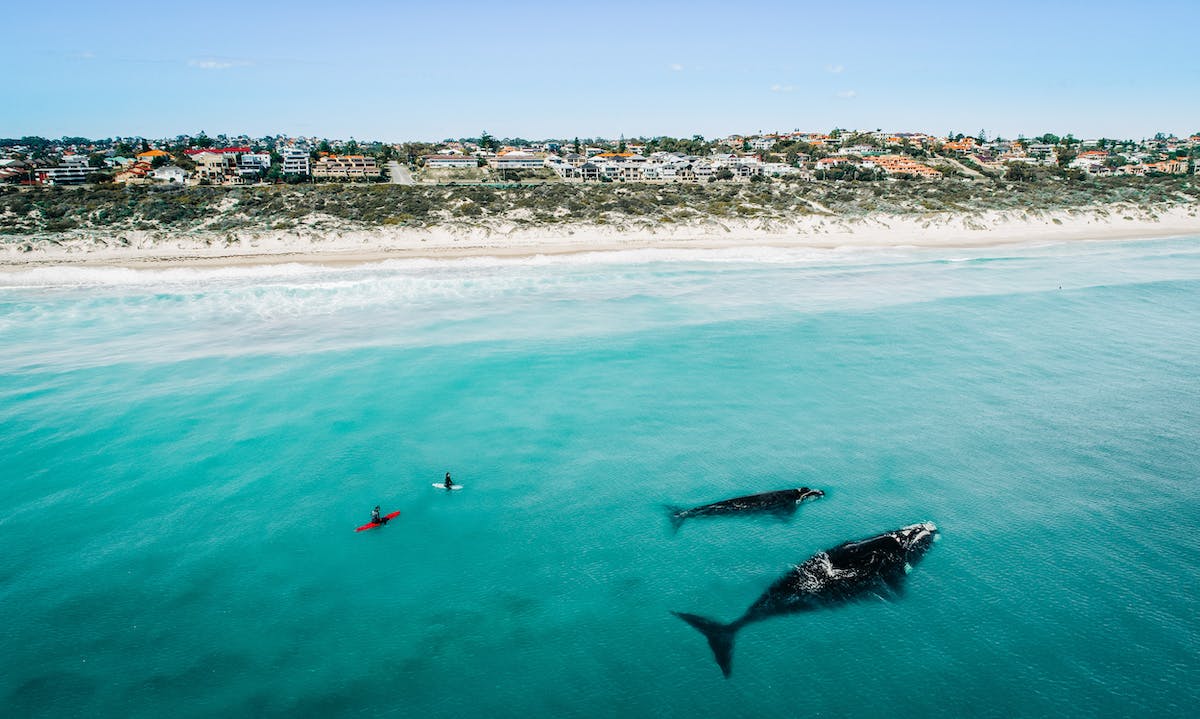The best spots for whale watching around Western Australia

Hump day? More like humpback whale day!
Give the screen-watching a break and head to one of WA’s best spots to watch some whales instead.
Ningaloo Reef
During their annual migration, Ningaloo Reef hosts one of the highest densities of humpback whales in the world: it’s a must-visit for anyone serious about seeing some whales. The UNESCO-listed reef is the longest fringing reef in the world, and in places, is within 100 metres of the shimmering white shoreline – meaning lots of opportunities to enjoy the rich ecosystem it holds. Get up close and personal with the wildlife on a snorkelling expedition, with the humpacks and of course, the iconic Ningaloo whale sharks. More of a land-lubber? Make sure to stop in at Vlamingh Head Lighthouse, just outside of Exmouth, for a great vantage point over the cape.
When: August-October, sometimes starting as early as June
Lalang-Garram/Camden Sound
After passing through Ningaloo, this huge pod – estimated at over 30,000 humpback whales – continue up to the Kimberley to give birth in the warm northern waters. Sheltered by the Buccaneer Archipelago and the Bonaparte Archipelago further north, it’s the perfect region to enjoy watching the whales and their new calves as they learn to swim and develop their blubber for the return journey. Camden Sound is also where you’ll find the Montgomery Reef – an inshore reef that is dramatically exposed with tidal changes of over eight metres, and home to six threatened species of marine turtles.
When: June-September.
Kinjarling/Albany
Albany’s history with whaling is well-documented, with the Cheynes Beach Whaling Station still in operation until 1978. Thankfully, things have taken a turn and you can now spot humpbacks and southern right whales as they frolic in the King George Sound on their journey north from Antarctica. The southernmost tip of WA has one of the longest whale-watching seasons in the world, starting in June and running all the way until October. From land, the Marine Drive Lookout has a great vantage point over Frenchman Bay, plus has convenient access via car – but if you want to feel that Antarctic wind in your hair, there are plenty of coastal trails in the area for varying levels of expertise. The Bald Head Trail is a 12.5 kilometre walk that extends right over the granite slopes of the Flinders Peninsula, while the Stony Hill Heritage Trail is a shorter, 500m loop that looks out over the Torndirrup National Park and the King George Sound.
When: June-October
Augusta
Like its southern neighbour Albany, Augusta has the benefit of being one of the few places where you can witness humpback and southern right whales interacting. In June, humpback whales are at their peak in the region, with large groups of males showing off their acrobatics in an attempt to court the females, while the following month sees the arrival of pregnant southern right whales to the area. Unlike the humpbacks, who travel north to give birth, the endangered southern right whales will give birth in the sheltered bays around Augusta. Lucky whale watchers will get to see newborn calves exploring Flinders Bay, or perhaps even get a rare sighting of a blue or minke whale. Coastal lookouts include the picturesque Cape Leeuwin Lighthouse, or heading to the Hamelin Bay Observation Deck.
When: Late May-August.
Geographe Bay
What goes up, must come back down – and the same goes for whales. After migrating north to give birth, humpback whales begin the journey back to the Antarctic waters with their young, resting and nursing in Geographe Bay en route. Enjoy one of the many (many!) lookouts along the bay, including the spectacular Cape Naturaliste Lighthouse, or the Point Picquet lookout.
Subscribe to our free newsletter!
When: September-December
Bremer Bay
Just east of Albany is Bremer Bay – a biodiversity hotspot that we’re still only just beginning to understand. What we do know? Off the coast is a continental shelf: a deep sea canyon, the depths of which contain a high concentration of bio-carbons. Every summer, the cold Antarctic current brings this nutrient-rich deep water to the surface. This, in turn, attracts an array of marine life that includes orcas (which you might know as killer whales), sperm, pilot and beaked whales, sharks, dolphins, and – wait for it – giant squid! Every time we learn a new fact about this southern wonder, our minds are blown. Head out for the day with Naturaliste Charters– a locally-run eco-tourism charter who play a key role in the research and conservation of the area.
Rottnest Island
We’re spoilt for choice in WA – with so many places up and down the coast allowing us to see some pretty majestic creatures year-round. In fact, we’re so lucky, that you can even spot blue whales on a day trip from the city! Less than 20 kilometres west of Rottnest Island is the Perth Canyon Marine Park. Encompassing over 2900 square kilometres and reaching depths of four kilometres, between March and May it’s also where you’ll find the largest concentration of blue whales in Australia. As well as blue whales, you might also spot humpbacks, orcas, minkes, sunfish and many more marine megafauna. If you’re viewing from dry land, head to the west end of the island; lookouts like the Cape Vlamingh Viewing Platform are perfect.
When: March-May (Blue Whales), September-November (Humpbacks)
Image credit: DG Imagery